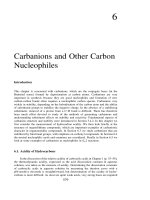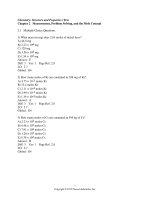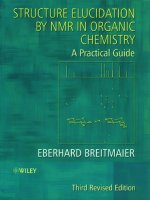Chemistry Structure Reactive
Bạn đang xem bản rút gọn của tài liệu. Xem và tải ngay bản đầy đủ của tài liệu tại đây (45.08 MB, 896 trang )
www.pdfgrip.com
Chemical Structure and Reactivity
www.pdfgrip.com
Great Clarendon Street, Oxford OX2 6DP
Oxford University Press is a department of the University of Oxford.
It furthers the University’s objective of excellence in research, scholarship,
and education by publishing worldwide. Oxford is a registered trade mark of
Oxford University Press in the UK and in certain other countries
c James Keeler and Peter Wothers 2014
The moral rights of the authors have been asserted
First Edition copyright 2008
Impression: 1
All rights reserved. No part of this publication maybe reproduced, stored in
a retrieval system, or transmitted, in any form or by any means, without the
prior permission in writing of Oxford University Press, or as expressly permitted
by law, by licence or under terms agreed with the appropriate reprographics
rights organization. Enquiries concerning reproduction outside the scope of the
above should be sent to the Rights Department, Oxford University Press, at the
address above
You must not circulate this book in any other binding or cover
and you must impose the same condition on any acquirer
Published in the United States of America by Oxford University Press
198 Madison Avenue, New York, NY 10016, United States of America
British Library Cataloguing in Publication Data
Data available
Library of Congress Control Number: 2013943937
ISBN 978-0-19-9604135
Typeset by the authors in LATEX
Printed in Great Britain by Bell & Bain Ltd, Glasgow
Links to third party websites are provided by Oxford in good faith and
for information only. Oxford disclaims any responsibility for the materials
contained in any third party website referenced in this work.
www.pdfgrip.com
Chemical Structure
and Reactivity:
an integrated approach
Second edition
James Keeler
Department of Chemistry and Selwyn College, University of Cambridge
Peter Wothers
Department of Chemistry and St Catharine’s College, University of Cambridge
www.pdfgrip.com
Preface
We are pleased to be able to present a second edition of this book, and have
taken the opportunity both to make some revisions and changes of our own,
as well as to act on the helpful suggestions that a number of people have been
kind enough to make. The overall approach and intention are much the same
as in the first edition, but we have reorganized some of the material and added
two new chapters to Part I. The first of these appears early on and introduces
the important topic of molecular symmetry, and the second further develops the
general discussion of the kinds of structures which occur when elements bond,
first to themselves and then with other elements.
The other main change to the text is the inclusion in each chapter of a number
of Self-test exercises, the answers to which are given at the end of each chapter.
We hope that completing these straightforward problems will help students to
get to grips with the material and gain confidence. The Questions associated
with each chapter now appear in the Online Resource Centre.
From the preface to the first edition
Our intention in writing this book was to produce a single text to accompany
the first year, and somewhat beyond, of typical UK degree courses in chemistry.
We also had it very much in mind that we wanted to treat the subject as a whole,
rather than dividing it up in the traditional way. This enables us to emphasize
the important connections between different topics, to develop a unified view of
the whole subject, and to present the material in rather a different way than is
conventional.
Our presentation is very much based on the idea that both structure and
reactivity can be understood, or at least rationalized, by thinking about the orbitals (atomic and molecular) involved, their energies, and the way they interact.
This is the unifying theme of the whole text, taking us right from the description
of the simplest molecules, through to an understanding of reaction mechanisms.
This central importance of an orbital description is reflected in the fact that three
chapters right at the start of the book are devoted to establishing these ideas.
The quantitative and more theoretical aspects of chemistry are not ignored,
but we have been at pains to present these in a way which emphasizes their wider
relevance. There are chapters covering the traditional physical chemistry topics
of thermodynamics, kinetics, and quantum mechanics, but these are interspersed
throughout the book and are strongly connected to the rest of the discussion.
www.pdfgrip.com
Preface
Content
The content of this book has been tailored to fit in with chemistry courses at UK
universities. However, a sufficiently wide range of topics are covered that the
text should also be useful in other countries.
Although this book contains a blend of inorganic, organic, and physical
chemistry, it is emphatically not a ‘general chemistry’ text of the type produced
for North American universities. Our approach, the content, and the starting
point are all significantly different from general chemistry texts. In particular,
we have included notably more organic chemistry than one typically finds in
such books.
Given that we certainly did not want to produce a book of overwhelming
size, we have had to be careful in the selection of the topics which are included
and the level to which they are discussed. Our feeling is very much that at this
level the most important thing is to understand the key ideas and concepts, and
know how to use them. We have therefore devoted a lot of space to setting out
these ideas carefully and in detail, so as to provide a sound basis for further
study.
Space has not allowed us to include lengthy discussions of the chemistry of
each group, nor to explore in detail the subtleties of synthetic organic chemistry,
nor to delve deeply into the intricacies of quantum mechanics. Nevertheless, we
believe that the material which is presented here forms both a coherent story and
a suitable basis on which to begin to get to grips with more advanced chemistry.
How the text is organized
The book is divided into three parts. The twelve chapters in Part I are closely
integrated with one another and designed to be studied in the order they appear.
Together, they set out the fundamental ideas needed for the study of chemistry at
this level. Although thermodynamics and kinetics appear in Chapters 7 and 12,
they are treated with the absolute minimum of mathematics, and in particular
without calculus. We have chosen this approach so that those students who are
still developing their mathematical skills can nevertheless obtain a good grasp of
these essential topics.
The chapters in Part II either introduce further topics or take the discussion
started in Part I on to a higher level. For example, with the aid of calculus,
Chapter 19 discusses thermodynamics in a somewhat more formal way than
was the case in Chapter 7. Similarly, the quantum mechanical ideas which were
used qualitatively in Part I are explored in more detail in Chapter 18. Generally
speaking, the chapters in Part II can be studied in any order.
In Part III, Chapter 22 is a brief but self-contained exposition of the key
mathematical ideas used in the rest of the book. While this chapter is certainly
no substitute for an appropriate course in mathematics, we hope that it will be
a convenient reference and handy refresher on the key ideas.
Each chapter has associated with it a set of questions, available from the
Online Resource Centre, which are designed to test both a basic understanding
of the material presented in the chapter, as well as the ability to apply the
concepts in more unfamiliar situations. We have also listed in Further reading
some other texts which can be consulted for an alternative view, or a more
advanced or detailed discussion.
v
www.pdfgrip.com
vi
Preface
Acknowledgements
We are very grateful to many of our colleagues in the Department of Chemistry
for finding the time and patience to answer our questions, direct us to relevant
literature, or provide data. In particular we would like to thank both Ruth
Lynden-Bell and Anthony Stone for greatly helping our understanding of the
underlying theory. Duncan Howe and Paul Skelton from the physical methods
section ran many NMR and mass spectra for us with great skill, for which we
are most grateful. Alfa Aesar (Heysham, Lancs.) contributed all the samples
used to run the NMR spectra, and the GCMS trace shown in Fig. 13.11 was
provided by Phil Teale and Simon Hudson (HFL Ltd, Newmarket): we thank
them for their contributions.
Several people read and commented on drafts of parts of the book and we
remain much indebted to them for their contributions. From Cambridge we
would like to acknowledge John Kirkpatrick, Finian Leeper, Rob Paton, Mike
Rogers, and Steven Smith. We would also like to acknowledge Michael Clugston
(Tonbridge School), Ian Cooper (Newcastle University), Bridgette Duncombe
(Imperial College, London), Jason Eames (University of Hull), David McGarvey (Keele University), Ruud Scheek (University of Groningen), Edward Smith
(Imperial College, London), Patrick Steel (Durham University), David Worrall
(Loughborough University), Rossana Wright (University of Nottingham), and
Timothy Wright (University of Nottingham).
Steven Smith has also prepared, with great skill and care, a significant part
of the solutions manual. Stephen Elliott contributed a great deal to the development of the Online Resource Centre, and we are very grateful to him for
producing some really outstanding resources.
This book has been typeset by the authors using the LATEX text processing system, in the implementation distributed by MiKTEX ( We
acknowledge the exceptional and continuing effort of the many people throughout the world who have contributed to the LATEX system and made it freely
available.
Cambridge, August 2013
www.pdfgrip.com
Online Resource Centre
The Online Resource Centre provides both students and teachers with additional
materials to complement and extend the text. It also provides a mechanism
for all users of the book to feed back their comments and observations to the
authors.
www.oxfordtextbooks.co.uk/orc/keeler2e/
online
resource
centre
For students
Each chapter has associated with it a set of Questions which can be downloaded
from the resource centre.
Throughout the text, relevant online resources are indicated by Weblink
boxes in the margin. On the website the links are arranged according to chapter,
so you should easily be able to navigate to the particular link you are looking
for.
Weblink 1.1
Online resources are indicated
by boxes like this one, located
in the margin.
www.pdfgrip.com
viii
Online resource centre
The material on the web is not simply a repeat of a diagram in the text.
Rather, it is an interactive resource in which you can alter the view of some
three-dimensional object, or see how a graph changes in real time when you
alter the parameters. There are four main kinds web resources
• Three-dimensional representations of molecules and lattices which you can
rotate, zoom and view in different ways.
• Three-dimensional representations of orbitals which you can also rotate
and zoom so that you can get a real feel for their shape.
• ‘Movies’ showing how orbitals change during reactions.
• Graphs or plots in which you can change the parameters (usually with realtime sliders), so that you can get a real feel for how the graph responds.
For teachers
Detailed worked solutions to all of the questions are available to bona fide
teachers; the resource centre gives details of how to request the solutions manual.
Registered adopters of this book will also have access to all the figures, in a
high-resolution digital format.
The Weblink resources can also be projected during lectures, and provide
both excellent illustrations of the topics as well as helping to vary the presentation during the lecture.
www.pdfgrip.com
Brief contents
Part I The fundamentals
1 Molecules and molecular structures: an overview
3
2 Electrons in atoms
35
3 Symmetry
79
4 Electrons in molecules: diatomics
99
5 Electrons in molecules: polyatomics
141
6 Bonding in solids
181
7 Thermodynamics and the Second Law
201
8 Trends in bonding
257
9 Bonding between the elements
297
10 Describing reactions using orbitals
319
11 Organic chemistry 1: functional groups
343
12 The rates of reactions
407
Part II Going further
13 Spectroscopy
441
14 Organic chemistry 2: three-dimensional shapes
503
15 Organic chemistry 3: reactions of π systems
539
16 Main-group chemistry
589
17 Transition metals
625
18 Quantum mechanics and spectroscopy
661
19 Chemical thermodynamics
723
20 Chemical kinetics
761
21 Electrochemistry
791
www.pdfgrip.com
x
Brief contents
Part III Reference material
22 Dimensions, units and some key mathematical ideas
Index
Orbital energies
833
869
877
www.pdfgrip.com
Full contents
Part I The fundamentals
1 Molecules and molecular structures: an overview
3
1.1
Simple covalent molecules
4
1.2
Structure determination by X-ray diffraction
14
1.3
Where are the bonds?
17
1.4
Types of bonding
19
1.5
Weaker non-bonded interactions
21
1.6
Solids
25
1.7
How to draw molecules
25
1.8
Common names and abbreviations
27
1.9
The ideal gas
28
1.10 Moving on
32
Answers to self-test exercises
34
2 Electrons in atoms
35
2.1
Introducing quantum mechanics
36
2.2
Introducing orbitals
39
2.3
Hydrogen atomic orbitals
43
2.4
Spin
62
2.5
Hydrogen-like atoms
63
2.6
Multi-electron atoms
64
2.7
Ionization energies
71
2.8
Moving on
77
Further reading
77
Answers to self-test exercises
77
3 Symmetry
79
3.1
Why symmetry is important
79
3.2
Symmetry elements and symmetry operations
80
3.3
Point groups
85
3.4
Applications of symmetry
89
3.5
Classification of orbitals according to symmetry
93
3.6
Moving on
96
Further reading
96
Answers to self-test exercises
96
www.pdfgrip.com
xii
Contents
4 Electrons in molecules: diatomics
4.1
Introducing molecular orbitals
4.2
H2 , He2 and their ions
4.3
Homonuclear diatomics of the second period
4.4
Photoelectron spectra
4.5
Heteronuclear diatomics
4.6
Moving on
Further reading
Answers to self-test exercises
5 Electrons in molecules: polyatomics
+
5.1
The simplest triatomic: H3
5.2
More complex linear triatomics
5.3
MOs of water and methane
5.4
Hybrid atomic orbitals
5.5
Comparing the hybrid and full MO approaches
5.6
Extending the hybrid concept
5.7
Bonding in organic molecules
5.8
Delocalized bonding
5.9
Delocalized structures including heteroatoms
5.10 Moving on
Further reading
Answers to self-test exercises
6 Bonding in solids
6.1
Metallic bonding: introducing bands
6.2
Ionic solids
6.3
Moving on
Further reading
Answers to self-test exercises
7 Thermodynamics and the Second Law
7.1
7.2
7.3
7.4
7.5
7.6
7.7
7.8
7.9
7.10
7.11
7.12
7.13
7.14
7.15
Spontaneous processes
Properties of matter: state functions
Entropy and the Second Law
Heat, internal energy and enthalpy
Entropy in terms of heat
Calculating the entropy change of the Universe
Gibbs energy
Chemical equilibrium
Finding the standard Gibbs energy change
Interpreting the value of Δr G◦
Δr H ◦ and Δr S ◦ for reactions not involving ions
Δr H ◦ and Δr S ◦ for reactions involving ions in solution
Applications
Acidity, basicity and pK a
How much product is there at equilibrium?
99
100
111
112
130
132
139
139
139
141
142
146
149
153
159
161
164
167
175
177
178
178
181
182
190
199
199
199
201
202
204
205
212
213
216
219
221
226
232
234
237
240
243
250
www.pdfgrip.com
Contents
7.16 Moving on
Further reading
Answers to self-test exercises
8 Trends in bonding
8.1
Electronic configuration and the periodic table
8.2
Orbital energies and effective nuclear charges
8.3
Atomic sizes across the periodic table
8.4
Ionization energies and electron affinities
8.5
Trends in oxidation states across the periodic table
8.6
Summary of the trends in orbital energies and sizes
8.7
Bonding in the elements – non-metals
8.8
Metallic structures
8.9
The transition from metals to non-metals
8.10 Moving on
Further reading
Answers to self-test exercises
9 Bonding between the elements
9.1
The effect of orbital size and energy mismatch
9.2
The classification of compounds as ionic or covalent
9.3
Structural trends across the periodic table
9.4
Radius ratio rules
9.5
Compounds with lower coordination numbers
9.6
Moving on
Further reading
Answers to self-test exercises
10 Describing reactions using orbitals
10.1 The redistribution of electrons in a reaction
10.2 HOMO–LUMO interactions
10.3 Interactions involving nonbonding LUMOs
10.4 Interactions involving π antibonding LUMOs
10.5 Interactions involving σ antibonding LUMOs
10.6 Summary of the effects of different HOMO–LUMO interactions
10.7 The role of protonation in reactions
10.8 Intramolecular orbital interactions
10.9 Rearrangement reactions
10.10 Moving on
Answers to self-test exercises
11 Organic chemistry 1: functional groups
11.1
11.2
11.3
11.4
11.5
11.6
Functional groups
Changing functional group level
Level two to level one – carbonyl addition reactions
Transformations within functional group level two
Transformations within functional group level three
Moving down from functional group level three
254
255
255
257
257
260
270
273
278
279
280
287
292
295
295
295
297
297
302
304
307
312
316
316
316
319
319
322
325
329
332
335
335
338
339
341
342
343
344
349
353
358
368
385
xiii
www.pdfgrip.com
xiv
Contents
11.7 Transformations within level one
Further reading
Answers to self-test exercises
12 The rates of reactions
12.1 The rate of a reaction
12.2 Rate laws
12.3 Temperature dependence
12.4 The energy barrier to reaction
12.5 Elementary reactions and reaction mechanisms
12.6 Reactions in solution
12.7 Sequential reactions
12.8 Analysing the kinetics of complex mechanisms
12.9 Chain reactions
Further reading
Answers to self-test exercises
392
405
405
407
408
410
413
414
417
418
419
426
431
437
437
Part II Going further
13 Spectroscopy
13.1 Mass spectrometry
13.2 Spectroscopy and energy levels
13.3 IR spectroscopy – introduction
13.4 Interpreting IR spectra
13.5 Nuclear Magnetic Resonance (NMR)
13.6 Coupling in NMR
13.7 More complicated coupling patterns – proton NMR
Further reading
Answers to self-test exercises
14 Organic chemistry 2: three-dimensional shapes
14.1 The relationships between isomers
14.2 The effect of rotations about bonds
14.3 Isomerism in alkenes
14.4 Enantiomers and chirality
14.5 Symmetry and chirality
14.6 The conformation of cyclic molecules
14.7 Moving on
Further reading
Answers to self-test exercises
15 Organic chemistry 3: reactions of π systems
15.1
15.2
15.3
15.4
15.5
Elimination reactions – the formation of alkenes
Electrophilic addition to alkenes
Enols and enolates
The reactions of enols and enolates
Introduction to aromatic systems
441
442
451
455
462
470
480
492
501
501
503
504
506
512
514
523
524
535
536
536
539
540
550
560
567
573
www.pdfgrip.com
Contents
Further reading
Answers to self-test exercises
16 Main-group chemistry
16.1 Overview
16.2 Key concepts in main-group chemistry
16.3 Hydrolysis of chlorides
16.4 Oxides
16.5 Brief survey of the chemistry of each group
16.6 Moving on
Further reading
Answers to self-test exercises
17 Transition metals
17.1 Orbital energies and oxidation states
17.2 Complexes
17.3 Bonding in octahedral complexes
17.4 High-spin and low-spin octahedral complexes
17.5 Magnetic and spectroscopic properties of complexes
17.6 Consequences of the splitting of the d orbitals
17.7 Tetrahedral and square-planar complexes
17.8 Crystal-field theory
17.9 Organometallic complexes
17.10 Aqueous chemistry and oxoanions
17.11 Moving on
Further reading
Answers to self-test exercises
18 Quantum mechanics and spectroscopy
18.1 The postulates of quantum mechanics
18.2 A free particle moving in one dimension
18.3 Particle in a box
18.4 Particle in a two-dimensional square well
18.5 The harmonic oscillator
18.6 Spectroscopy and energy levels
18.7 The IR spectrum of a diatomic
18.8 Vibrations of larger molecules
18.9 Raman spectroscopy
18.10 Summary of the features of vibrational spectroscopy
18.11 The rigid rotor
18.12 The microwave spectrum of a diatomic
18.13 Vibration–rotation spectrum of a diatomic
18.14 The hydrogen atom
18.15 Electronic transitions
Further reading
Answers to self-test exercises
587
587
589
590
591
601
610
611
623
623
623
625
626
630
632
639
641
643
647
649
649
655
658
658
659
661
663
669
672
681
683
690
693
702
704
705
706
708
713
717
718
721
721
xv
www.pdfgrip.com
xvi
Contents
19 Chemical thermodynamics
19.1 The First Law
19.2 Work of gas expansions
19.3 Internal energy, enthalpy and heat capacity
19.4 The Gibbs energy
19.5 The mixing of ideal gases
19.6 Chemical equilibrium
19.7 Equilibria involving other than gases
19.8 Determination of the standard Gibbs energy change
19.9 The temperature dependence of the equilibrium constant
19.10 Determination of absolute entropies
Further reading
Answers to self-test exercises
20 Chemical kinetics
20.1 Measuring concentration
20.2 Integrated rate laws
20.3 Other methods of analysing kinetic data
20.4 Collision theory
20.5 Potential energy surfaces
20.6 Transition state theory
Further reading
Answers to self-test exercises
21 Electrochemistry
21.1 Electrochemical cells
21.2 Thermodynamic parameters from cell potentials
21.3 The Nernst equation and standard cell potentials
21.4 The spontaneous cell reaction
21.5 Summary
21.6 Types of half cells
21.7 Assessing redox stability using electrode potentials
21.8 The limits of stability in aqueous solution
21.9 Using cell potentials to determine thermodynamic parameters
21.10 Oxidation state diagrams
21.11 Measurement of concentration
Further reading
Answers to self-test exercises
723
724
727
733
738
741
743
750
752
755
759
760
760
761
761
769
777
778
783
784
789
789
791
792
796
799
805
806
807
811
814
816
820
825
829
829
Part III Reference material
22 Dimensions, units and some key mathematical ideas
22.1
22.2
22.3
22.4
Dimensional analysis
Units
Trigonometric functions
The exponential function
833
833
839
847
851
www.pdfgrip.com
Contents
22.5 Calculus: differentiation
22.6 Calculus: integration
22.7 Differential equations
Further reading
Answers to self-test exercises
Index
Orbital energies
856
861
865
867
867
869
877
xvii
www.pdfgrip.com
This page intentionally left blank
www.pdfgrip.com
Part I
The fundamentals
Contents
1 Molecules and structures: an overview
2 Electrons in atoms
3 Symmetry
4 Electrons in molecules: diatomics
5 Electrons in molecules: polyatomics
6 Bonding in solids
7 Thermodynamics and the Second Law
8 Trends in bonding
9 Bonding between the elements
10 Describing reactions using orbitals
11 Organic chemistry 1: functional groups
12 The rates of reactions
www.pdfgrip.com
This page intentionally left blank
www.pdfgrip.com
Molecules and molecular
structures: an overview
Key points
• The bonding in simple covalent molecules can be described using Lewis structures
in which the focus is on bonding and non-bonding pairs of electrons.
• A single Lewis structure may not be an adequate representation of the bonding.
• The shapes of simple molecules can often be predicted using the valence shell
electron pair repulsion (VSEPR) model.
• Molecular structures are determined using X-ray diffraction.
• In drawing molecular structures, lines between atoms do not always represent bonds.
• The basic types of bonding are covalent, ionic and metallic.
• There are weaker, non-covalent, interactions between molecules.
• For an ideal gas, the pressure, volume, temperature, and amount in moles are related
by the ideal gas equation.
This book is concerned with trying to understand why molecules form, what
determines their shape, and what it is about a particular molecule which makes it
react in a certain way. This is undoubtedly an ambitious task which has already
occupied chemists for hundreds of years, and will no doubt keep them employed
for many years to come. However, a great deal of progress has been made and,
through studying this book, you will see that with the aid of a relatively small
number of fundamental principles it is possible to understand much about the
chemical world of structures and reactivity.
In this opening chapter we gather together the key concepts that are commonly used in describing bonding and molecular structures, together with some
related ideas – such as delocalization, oxidation state, and formal charge – which
may be less familiar to you. In the chapters that follow, we will have a lot more
to say about the theories which lie behind all of this.
We will then move on to look at the different types of bonding which are
encountered and their particular characteristics. Along the way, we will explain
how X-ray diffraction is used as the ultimate method of structure determination,
and what the limitations of this method are.
The chapter closes with a discussion of different types of solid materials, and
the behaviour of simple gases – something which will be very useful to us later
on.
1
www.pdfgrip.com
4
Chapter 1 Molecules and molecular structures: an overview
1.1 Simple covalent molecules
If a chemist is asked to draw the ‘structures’ of the molecules H2 , H2 O, CH4 and
HCl there is a good chance that the resulting diagrams would look something
like the following.
CH4 is tetrahedral, but as we are
more concerned in this section
with electron counting than
shape, we will not attempt to
draw representations of the
three-dimensional structures.
H
H
H
O
H
H
H
C
H
F
H
H
In these diagrams the lines are of great significance as they indicate the presence
of covalent bonds between the two atoms which they connect. Such a bond is
understood to arise from the sharing of a pair of electrons, and although we
will see the following chapters that covalent bonding is rather more complex
than this, nevertheless this simple statement does capture the essence of what a
covalent bond is.
These diagrams also reflect the usual valency of each atom. Hydrogen and
fluorine each have one bond, whereas oxygen has two and carbon has four.
1.1.1 Electron counting: bonding pairs and lone pairs
If each line represents a shared pair of electrons, usually called a bonding pair,
then we can work our from these diagrams how many electrons are involved in
bonding and then compare this to the total number of electrons in the molecule.
For example, in H2 each atom contributes one electron giving a total of two
for the molecule. These two for the bonding pair indicated by the line: all the
electrons are accounted for.
Oxygen has six electrons in its outer shell (remember that it is usually only
these outer electrons which are involved in bonding). In H2 O one of these
electrons shares with the electron from one of hydrogen atoms, creating a
bonding pair, and in a similar way there is a second bonding pair formed by
sharing with the other hydrogen. The remaining four electrons from the oxygen
are arranged as two non-bonding pairs or lone pairs of electrons. It is common
to indicate the arrangement of electrons into bonding and non-bonding pairs by
the use of ‘dots’, as shown below.
H
H
H
O
H
H
H
C
H
F
H
H
In CH4 each of the four electrons in the outer shell of the carbon atom shares
with an electron from one of the hydrogen atoms, thus giving four bonding
pairs; there are no lone pairs. Finally, in HF the fluorine has seven electrons, one
of which is shared to give a bonding pair with the remaining six forming three
lone pairs.
In each of these simple molecules the oxygen, carbon and fluorine atoms
acquire a share of eight electrons. This is sometimes described as ‘completing
the octet’ and is a common feature of many molecules involving non-metals.
In molecules such as CO2 and H2 CO (methanal) there are double bonds
which involve the sharing of two pairs of electrons. For the oxygen atoms, two
of the electrons are shared giving the two pairs which form the double bond,
www.pdfgrip.com
1.1 Simple covalent molecules
leaving two lone pairs. For the carbon atoms, there are four bonding pairs, just
as in CH4 .
O
O
C
O
C
H
H
An important feature of these diagrams is that they account for all of the
electrons in the molecule. For example, in CO2 the carbon outer shell contributes four electrons, and each oxygen contributes six, giving a total of sixteen
electrons. The diagram above shows the presence of eight electron pairs, thus
accounting for all the electrons in the molecule.
Molecular structures drawn in this way to show the bonding and lone pairs
of electrons are often called Lewis structures.
1.1.2
Formal charge
Given a Lewis structure we can compare the number of electrons associated
with a particular atom with the number of electrons that a neutral atom would
have. If these two differ, then we can assign a formal charge to that atom. It is
important to understand that these charges reflect the way in which the Lewis
structure is drawn and the counting method used. There is no guarantee that
the resulting charges correspond to reality – which is why they are described as
‘formal’ charges.
The formal charge is worked out in the following way.
1. The number of electrons associated with a particular atom is determined
by counting one for each bonding pair and two for each lone pair. Let this
number of electrons be Ne .
2. The number of valence electrons associated with the neutral atom, Nv , is
equal to the group number for Groups 1–12, or the group number minus
10 for Groups 13–18.
3. The formal charge is (Nv − Ne ).
For example, in methanal the carbon has four bonding pairs and no lone pairs,
hence Ne = 4. Carbon is in Group 14, thus Nv = 4 and so it follows that the
atom has no formal charge. The same is true for the oxygen, and indeed in all
of the simple molecules discussed so far none of the atoms has a formal charge.
If a molecule has an overall charge then at least one of the constituent atoms
must bear a formal charge. Let us work out these charges for the molecules
whose Lewis structures are shown below (note in each case we have arranged
the electrons so that octet of the central atom is complete).
+
+
H
-
H
O
H
H
H
N
H
B
H
H
H
H
H
Around the oxygen in [H3 O]+ there are three bonding pairs and one lone pair,
so Ne = 3 + 1 × 2 = 5. Oxygen is in Group 16, so Nv = 16 − 10 = 6. The formal
charge on the oxygen is therefore Nv − Ne = 6 − 5 = +1. For each hydrogen
5
www.pdfgrip.com
6
Chapter 1 Molecules and molecular structures: an overview
Ne = 1 and Nv = 1, so for these the formal charge is zero. Note that the sum
of the formal charges on each atom must be equal to the overall charge on the
molecule.
Around the nitrogen in [NH4 ]+ there are four bonding pairs so Ne = 4.
Nitrogen is in Group 15, so Nv = 5 and hence the formal charge is +1. The
calculation for the hydrogen atoms is as before. Finally, turning to [BH4 ]− Ne = 4
once again, but as boron is in Group 13, Ne = 3. The formal charge is therefore
3 − 4 = −1. The structures are redrawn below showing the formal charges for
atoms for which this is not zero.
H
+
O
H
H
N+
H
H
H
B
-
H
H
H
H
H
Calculations show that in [H3 O]+ the oxygen in fact bears a (partial) charge
of −0.44, whereas each hydrogen bears a charge of +0.48, which is a far cry from
the picture above. One reason you can see why the formal charges may not be
realistic is that in determining them it is assumed that a bonding pair is shared
equally between the two atoms involved. Unless the two atoms are the same,
this is clearly a poor assumption. It is important to realize that formal charges
in Lewis structures are more a consequence of the way the structure in drawn
than a prediction of the real electron distribution.
Self-test 1.1 Drawing and interpreting Lewis structures
(a) Draw a Lewis structure for BeH2 (in which the atoms are arranged
H–Be–H); show that your structure accounts for all the electrons and
show that none of the atoms has a formal charge.
(b) Draw a Lewis structure for the ion [FH2 ]+ (in which the atoms are
arranged H–F–H); show that the formal charge on the fluorine is +1.
(c) Draw a Lewis structure for the imine H2 C=NH; determine the formal
charge on the nitrogen.
1.1.3 More complex structures
When we move away from the simplest molecules we quickly find that there
is often more than one way of drawing a Lewis structure, and it is often not
clear which alternative is the best. For example, consider the molecule dimethyl
sulfoxide (DMSO), (CH3 )2 SO, for which two alternative Lewis structures are
given below.
O -
O
H
A
H
S
H
B
C
C
H
H
H
H
S
H
+
C
C
H
H
H
H
In A the octet has been completed around the carbon atoms and also around
the oxygen, and you can easily work out that there is no formal charge on these









